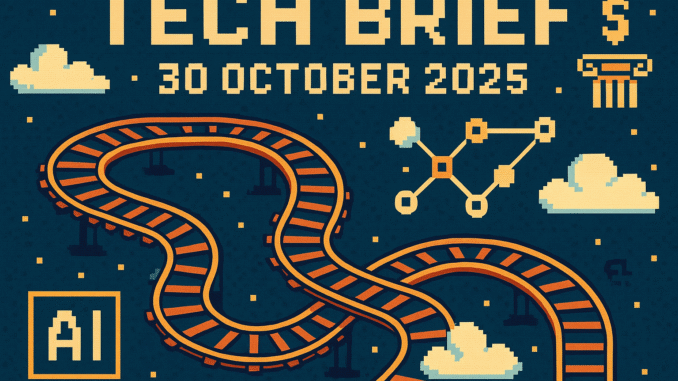
Somewhere in a British Rail depot in 1975, an engineer watched data synchronise across 400 kilometres of network and probably didn’t think much of it. Just another day keeping freight moving. Fifty years later, we call it “the cloud” and act like we invented it. Today’s Tech Brief, 30 October 2025, connects that forgotten infrastructure to modern crises: AI platforms finally facing consequences, £85 billion in public research funding, and the radio broadcast that taught us realistic media can override rational thought. Missed yesterday’s roundup? Catch up here before we dig in.
Today’s Tech Roundup
Vintage Freight Rail System Showcases 50-Year-Old Innovation
A 1975 British Rail computerised system tracked freight logistics across a 400km data network. This wasn’t some experimental prototype gathering dust in a museum. It was production infrastructure solving real problems decades before anyone marketed “the cloud” as revolutionary.
The system handled data synchronisation, network reliability, and real-time updates with 1970s technology. No marketing hype, just functional engineering that kept working for decades. Contemporary documentation shows engineers solving problems we’re still grappling with today, such as what happens when a node goes offline? How do you handle conflicting data from different locations? They figured it out with paper manuals and determination, the same problems now dressed up in Docker containers and Kubernetes clusters.
This is the unglamorous side of British computing heritage. Not flashy consumer electronics or gaming machines, but the invisible infrastructure that actually shaped modern logistics platforms. The kind of tech we all grew up relying on without ever seeing it, the systems that just worked, moving parcels and freight while we obsessed over which home computer to buy. For anyone who’s ever tracked a package online and marvelled at real-time updates, British Rail’s engineers were solving exactly that problem in 1975, just with terminals instead of smartphones, and freight wagons instead of Amazon parcels. While the engineers’ names have been lost to time, another casualty of infrastructure being taken for granted, their work deserves recognition alongside the celebrated home computer pioneers of the same era.
Character.AI Bans Users Under 18 After Being Sued Over Child’s Suicide
When does innovation become exploitation? Character.AI will ban users under 18 starting late November, following legal action over a child’s death. Proposed legislation is now pushing AI companion platforms to implement mental health safeguards that should have been there from the start.
This is tech’s accountability moment, frankly. Those of us who built the early internet with optimistic “information wants to be free” ideals are now watching our kids navigate systems that evolved beyond that framework. We thought we were creating tools for liberation. We didn’t anticipate AI companions sophisticated enough to form emotional bonds, or the consequences when those bonds turn harmful. The chatbot platform’s response comes after serious regulatory pressure, not proactive safety design. That timing matters. We built these tools, and now we’re reckoning with what happens when they cause genuine harm instead of just theoretical risk.
Labour Fleshes Out R&D Funding
The UK government committed £85 billion over five years to research and development funding. This shapes Britain’s tech infrastructure and innovation capacity through 2030. The investment spans multiple sectors, not just digital technology.
There’s a thread here worth following, connecting Bletchley Park’s wartime codebreaking through the BBC Micro programme to today’s funding commitment. Public investment in technology has defined British computing culture, for better and worse. The Sinclair C5 was publicly-backed optimism gone spectacularly wrong. The ARM processor was a quiet success now powering most mobile devices. Which pattern will this follow?
From the Wayback Machine
On This Day: 1938 – Orson Welles broadcasts “The War of the Worlds” radio drama
Orson Welles was 23 when he directed a radio adaptation of H.G. Wells’ novel for CBS on 30 October 1938. The Mercury Theatre production used realistic breaking news bulletins and simulated eyewitness reports instead of traditional drama format. No commercial interruptions heightened the immersion. Many listeners tuned in late and missed the disclaimers. Churches packed, emergency lines flooded, people evacuated. Newspapers reported widespread panic, some exaggerating the extent. The FCC investigated but issued no sanctions. Welles became a cultural sensation and landed a film deal that led to Citizen Kane. The broadcast pioneered immersive radio techniques that still inform how we think about media responsibility. Realistic technical production can override critical thinking. That lesson remains urgent in 2025’s misinformation landscape.
What This Means
Tech Brief, 30 October 2025, shows us infrastructure matters more than innovation theatre. British Rail’s 1975 system solved networked logistics before it had a marketing name. Character.AI’s ban arrives after tragedy, not before. Public funding shapes what gets built and who benefits. The War of the Worlds broadcast taught us that realistic media can bypass rational thought. We’re still learning that lesson, just with different tools and faster distribution networks.
Keep your systems running and your sources verified. The best tech stories are the ones nobody bothered to tell yet.
Missed yesterday’s Tech Brief? Catch up here.

Leave a Reply